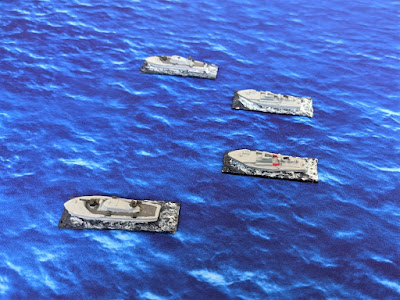With continued good gaming weather, I set up the popup and it was back to the yard for another weekend game. This time we heading for the narrow seas pulling out the World War 2 coastal forces for some action and David Manley's (relatively) new coastal forces rules Narrow Seas. Our group really enjoys Mr. Manley's rules, so we were looking forward to playing these.
For our game, I decided to set up a Royal Navy attack on a German coastal convoy. I set up two Royal Navy forces, each with a pair of motor gun boats (MGBs) and Vosper motor torpedo boats (MTBs). One set of MGBs had a forward 2 pdr, while the others had a forward twin HMGs with an aft 20mm gun. The MTBs had two torpedoes and aft facing twin HMGs.
 |
| Royal Navy group 1 |
 |
| Royal Navy group 2 |
The Germans had four merchants and four escorts. There was one Raumboote with only a 20mm gun, but the other three were larger vessels with 88mm or 105mm guns, along with more 37mm and 20mm guns.
 |
| German convoy setup |
The Narrow Sea rules use a mix of stuff from his earlier rules (such as vessel damage levels instead of damage points) and new stuff (card drawing for move and fire activation). Spotting is done continuously throughout the turn - which seems unusual, but works out fine. When firing weapons, you determine if the attack is advantaged or disadvantaged, giving a +1 or -1 modifier for the attack. All combat uses D6s and the rules use hit location rules to determine upper deck (weapon, bridge, etc.) hits. The basic turn sequences is for large ships to move, followed smaller boats (both determined by card draws), then torpedo movement, and then gunfire (determined by card draw). There is also air phases and a damage control phase. Overall, we felt pretty comfortable with the rules after a couple turns and fire phases.
For our game, the Royal Navy groups set up on either side of the convoy and closed in. In hindsight it might have been better to attack from one side, to reduce the number of escorts that could easily engage. But it was the first playthrough of the rules (and we were social distancing), so we wen with the two sided attack.
After a couple turns of movement, we pulled into spotting range an the shooting started. The 2 pdr MGBs opened fire, but did not have much luck with hits. One accompanying MTB launched torpedoes, while the other waited to get a little closer. German return fire was much more accurate, doing heavy damage to one MGB and MTB, forcing both to try to withdraw. So, the MTB that waited to launch torpedoes would never get the chance.
 |
| Torpedoes away! |
With torpedoes expended, it seemed like a good time to head for home.
 |
| Torpedo shots looking okay |
 |
| Attack group 1 moving away at best speed |
On the other side of the convoy, group 2 had puled in spotting range and fired off all their torpedoes.
 |
| Torpedoes loose! |
German return fire was accurate and caused heavy damage ad destruction on the small British ships.
 |
| One of the heavily-armed escort trawlers blasts an MGB |
 |
| A depth charge on an MTB is hit and explodes with dramatic effect |
The surviving British made their way off the board, with fingers crossed that the torpedoes would exact some revenge.
 |
| Torpedoes closing in on the convoy |
But it wasn't to be. The British dice went cold (no hits in half-a-dozen rolls) and the German convoy continued on its way.
 |
| Two torpedo misses |
 |
| Four more misses |
 |
| Convoy safely steaming to port |
Counting up the damage, the Germans had some minor hits on the escorts. While the British lost two MTBs and an MGB. Definitely not a good day for the Royal Navy, but still a fun game.
It was good to get the coastal forces out again and we enjoyed playing the new Narrow Seas rules. We also had some time for show & tell as Kevin had just gotten two new ships from War Times Journal; the battleship (or armored cruiser) Texas and protected cruiser Raleigh.
 |
| Raleigh (foreground) and Texas (middle) with the Charlemagne for size comparison |
Overall, another good day of outdoor gaming.


































